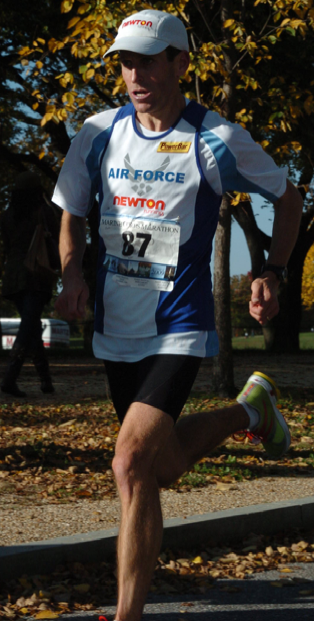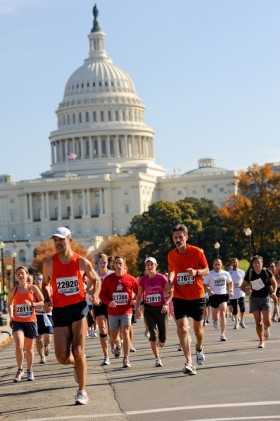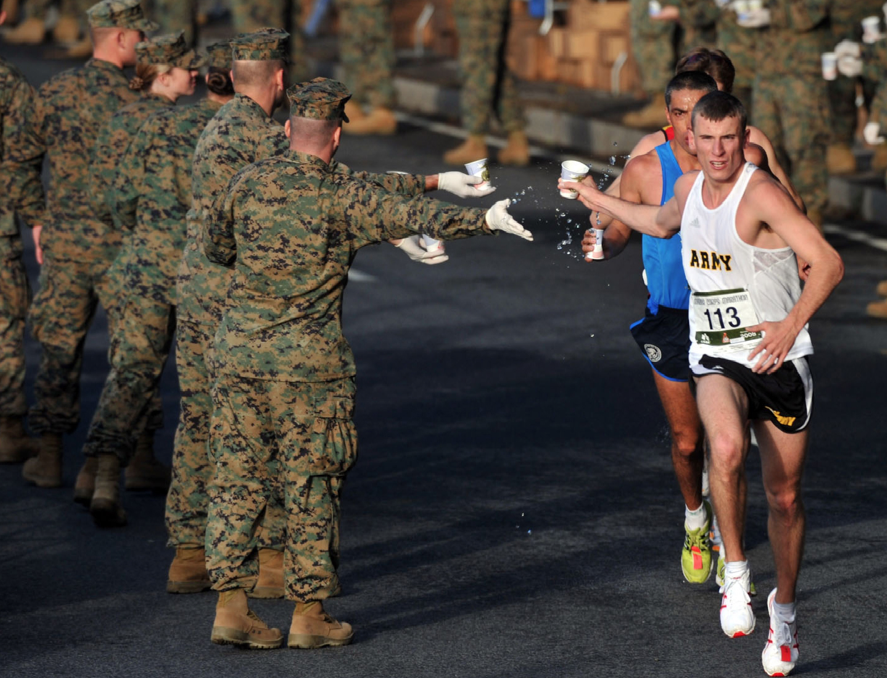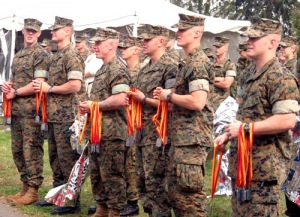 For a few nail-biting weeks, uncertainty clouded the future of the 38th Marine Corps Marathon. But it’s all systems GO! for 30,000 runners now that the U.S. government shutdown has ended. The world’s largest marathon without prize money will be run October 27 through the nation’s capital as scheduled. “Runners, we are on,” director Rick Nealis said in an amusing video on YouTube that was posted several days ago.
For a few nail-biting weeks, uncertainty clouded the future of the 38th Marine Corps Marathon. But it’s all systems GO! for 30,000 runners now that the U.S. government shutdown has ended. The world’s largest marathon without prize money will be run October 27 through the nation’s capital as scheduled. “Runners, we are on,” director Rick Nealis said in an amusing video on YouTube that was posted several days ago.
I will be running Sunday. The marathon is an event I look forward to each year. It was my first marathon in 1988 and have finished the race 21 times, with two overall top-five finishes and 3 Masters wins. At age 47, I am still learning new things and love to share lessons learned with others. More importantly, I have represented the U.S. Air Force in the military friendly event for over 20 years.
The day before the race, I will be presenting a talk on “Marine Corps Marathon Race Day Strategies” at the American Medical Athletic Association’s Symposium. Many national leaders in running medicine and exercise science will be presenting at this event. You can view the agenda and register here; there is still space in the conference. http://www.amaasportsmed.org/meetings/AMAA_MCM2013.htm
Here is the handout of my talk. The tips can apply to other races. ………………………………………………………………………………………………………………………………………………..
As you enter the week prior to the Marine Corps Marathon here are a few visualizations to help you set your plan. Running your best 10K is mostly about fitness. Running your best marathon is part art, science, guts, faith in what you can do, and a little luck. At 47 years old, I’m still learning new things and love to share lessons with others.
As you enter the week prior to the race here are a few strategies to help you set your plan. The best analogy I can think of is this: if you have trained your body properly with the right mix of aerobic level training and some up-tempo stuff in recent weeks, you have built your efficient hybrid engine ready to race the marathon.
Many of you have driven in a Prius and watched the subtle shifts between gas and electric on the dashboard. You do not perceive these shifts. Your engine (muscles) run on a mixture of gas (sugars) and electric (fats). Utilizing gas or electric power depends on the effort. This is why slow aerobic training is critical for marathon success, you build a massive electric (fat burning) engine.
You are starting the race with one gallon in the gas tank–assuming you have eaten a nice meal the night before with a light breakfast top off. If you race in all gas mode, your engine will run about 1.5 hours at a strong pace, then you are out of gas. If your effort is mostly electric you can run for hours, but not as swiftly.
With the correct effort you:(1) will use the proper fuel mix and you will be efficient for duration of your event; and (2) you can even do some topping off along the way. Going too hard early will sabotage the day by not only depleting the gas but also shunting all blood flow to working muscles, thereby not allowing the aid station top-offs to assist.
Running utilizes about 1kcal/Kg/Km. So for a lean marathoner of 80 kg you need about 3360 kcals (80kg x 42 km) to make it. The gas is the glucose-utilizing pathway. Even fully carbo loaded, your stored liver glycogen (300-500kcal), muscle glycogen (1000-1500kcal), and blood glucose (less than 20 kcal). Glucose is easy to access for ready energy but adds up to less than 2000kcal. The fat utilizing pathway is the electric. In marathons you must be in hybrid mode to make it. Hybrid is where your energy (ATP) is coming from both fuel sources. Conserving the gas and using electric early in the race is critical.
Many runners are in great “10k shape” (an all gas event), run their marathon in the all gas mode, and then crash into that wall. Glycogen sparing strategy need not apply in races of less than an hour as long as you had a good pre-event meal to fill the tank. In marathons and ultras, top end anaerobic fitness matters little and can only be applied very near the finish. Glucose gives 36 ATP per molecule with a limited supply, fat 200-400 ATP per molecule and an unlimited supply. You must tap into the fat burning tank. Now you know how a bird can migrate 7000 miles without an aid station. It’s all about the pace.
Another key to teaching your body how to burn fat and to maximize aerobic development is to not eat before or during your long runs. If you are reading this for the first time before this week’s race then apply this to your next marathon in the spring. Your body adapts to exposures and if sugar is constantly accessible, then it will not learn how to burn fat.
You also want to convert your fast-twitch fibers to make them as “red” (oxidative) as possible. Easy and moderate effort long runs of 2 hours in a fasted state will drain the slow twitch fibers (“red” fibers) of glycogen and force more capillarization of the fast twitch (mix “white”/”red”) fibers, making them more “red”. You are doing speed work by running slow with this method, making the powerful fast twitch fibers aerobic. Distance runners in events from 800 meters to marathons through generations have all trained this way. This is part of the Lydiard method. Only recently have we been convinced that we need lots of sugar before and during long runs. Race day is different as you are going for performance, not creating adaptations.
 So how do you know you are running in your best hybrid mode?
So how do you know you are running in your best hybrid mode?
This is difficult because the body sense at this level (Aerobic Threshold) is not as profound as Lactate Threshold (or Anaerobic Threshold). A slight increase from your optimal pace will switch you from hybrid to all gas without you realizing it. The effects are felt miles later. Charging and surging early will tap your gas quickly. If you want to speed up early, I have this recommendation: Don’t! Instead, relax and maintain a comfortable effort, not always a specific speed. You should feel easy in the early stages; it is a marathon.
You must rehearse this training. I focus on relaxation and belly breathing. If I’m breathing 1 cycle to 5 steps, then I’m hybrid. If breathing faster, I’m using mostly glucose as fuel. Belly breathing allows the lower belly to blow up like a beach ball on inhalation as your powerful diaphragm contracts. You will fill the lower lung areas where oxygen exchange occurs. Notice the breathing efforts of those around you. Many are rapid breathing. They will suffer somewhere past half way. Practice nasal breathing; it forces belly breathing and prevents you from running in too high a gear. Nasal breathing also allows CO2 to rise naturally to assist in offloading the oxygen to the tissues. Blowing off CO2 binds the oxygen to the hemoglobin, inhibiting offload to the tissues.
Rehearse complete relaxation from the top down- eyes, jaw, shoulders. Allow your legs to relax and extend behind you. Your core is solid and your legs are the springs. Find you own cue for this. If you use a heart rate monitor in training strongly consider one during the event.
In a marathon, the last 3-4 miles you will be mostly gas to maintain the same speed as fatigue sets in and heart rate rises. The breathing is usually on a 3 to 4 steps per breath cycle- that is okay Still stay relaxed and use the cues that you have rehearsed to keep your form.
Onto running form: Land softly, especially on the early downhills. Focus on good form. I run with a forefoot/midfoot landing harnessing elastic recoil. Gently landing on and rolling from the heel can work too. Do not overstride with fully extended leg. Focus on posture and hip extension. Your trunk will lean forward slightly; think “face forward” and look ahead. I’m never sore after marathons now and feel I can keep doing them until that day down the road that I enter the retirement home. Find a nice rhythm. Races are filled with excitement and distractions. For you there are no distractions, just peace in the moment. The art of a marathon is to relax and be in the moment.
Your shoes matter too. Make strong consideration to not running in minimalist racers unless you have trained substantially in them and adapted your structure to less foot support and a natural-style gait. I advocate gradually adapting all of your training into more minimal and level shoes. If you relax your lower legs and load the springy tendons in your feet and lower legs, running shoes with no heel elevation (zero-drop), puts your body in perfect position to allow natural elastic recoil of plantar fascia, Achilles and lower leg tendons, and hip flexors.
New research and runners’ experience are now making the case for running with a focus on form and questions modern running footwear. The evolving world of modern sports medicine is going back to the future too and rediscovering what evolution has taught us. For a library of information of footwear, see the articles and videos on The Natural Running Center. Also visit Dr. Mark’s Running School on upper right of home page of Two Rivers Treads at http://www.tworiverstreads.com.
 Have a course specific plan for your race. For the Marine Corps Marathon this is pretty simple as the course is mostly flat. Relax and warm up on the first uphill in Arlington. Find your rhythm on the scenic and mostly flat Rock Creek Park section miles 4-8. Revel in the fact that you are not climbing out of Georgetown and around the Reservoir for 2013. Do not take the bait and get too excited by the Georgetown crowds at mile 10. Relax and enjoy the tour through the Mall. Key a nice rhythm on the peaceful stretch around Hains Point and make sure to get fuel and fluids as rehearsed. This is my favorite part of the race. There are no distractions. Relax head to toe and make sure you are belly breathing.
Have a course specific plan for your race. For the Marine Corps Marathon this is pretty simple as the course is mostly flat. Relax and warm up on the first uphill in Arlington. Find your rhythm on the scenic and mostly flat Rock Creek Park section miles 4-8. Revel in the fact that you are not climbing out of Georgetown and around the Reservoir for 2013. Do not take the bait and get too excited by the Georgetown crowds at mile 10. Relax and enjoy the tour through the Mall. Key a nice rhythm on the peaceful stretch around Hains Point and make sure to get fuel and fluids as rehearsed. This is my favorite part of the race. There are no distractions. Relax head to toe and make sure you are belly breathing.
Save energy for the 14th St. Bridge, this is where things can get tough. 2 miles of lonely cement and often into the wind. A wonderful feeling is exiting the Bridge and entering Crystal City. If you feel really good then is it time to take some chances and charge. You can smell the barn. Remember, if you feel really good in the early stages and feel like you want to speed up… don’t!. It is a marathon and you should feel good in the early miles.
Now a few extra ways to get from start to finish quicker on the same gallon.
• Do not sabotage your event by having a large carbohydrate heavy breakfast the morning of the race. This will increase your insulin levels and lock out the ability to burn fat. Fill your glycogen stores by not running and eating adequate amounts of healthy carbohydrates the 3 days prior. Do not overload, you can only store a specific amount. A light breakfast of mix carb/fat/protein is a good thing as well as your morning coffee if you are a coffee drinker.
• If you can add a little gas along the way then you can run more in gas mode. This helps a little at best. If running too fast or if temperature high you shunt blood to working muscles to work and skin to cool and diverts from the gut, so nothing digests. Plus you are burning quickly through the glucose/gas. If you are in hybrid in the early going you can continually add some fuel. So the key is not only the correct fuel, but the right pace. A Powergel every 30 minutes is easy to digest and tops off the tank. Carry a few with you at the start. The weight is nothing compared to the benefit you will get. If you do the gels then you can drink water instead of the energy drinks which are often less predictable on the run. The Marine Corps Marathon has several aid stations along the way. See their website for details.
• The early downhill out of Arlington (mile 2-3) is fun but if run too hard it can damage your quads; go smooth and easy down the hill. Allow gravity assist you down. Do not overstride and heel hit on the downhills; remember run over the ground not into the ground.
• If it is windy get behind a group. This can save lots of physical and mental energy.
• If you are having a “bad patch”, then try to refocus on relaxing, fuel a bit (sometimes a blood glucose drop triggers the sense of doom), and have faith in your training and race plan. Another nice trick is when you hit mile 21 it is not 5 miles to go, it is 4 and change. Mile 22 is 3 and change to go. Just run to the next mile marker and count them down one by one. Smile and enjoy the crowds.
• Do not over-drink water. This can lead to a dangerous condition called hyponatremia. See guidelines
[http://www.usatf.org/groups/coaches/library/2007/hydration/IMMDAAdvisoryStatement.pdf]
• If it is going to be hot read this article [http://naturalrunningcenter.com/2012/09/03/running-heat/] I wrote after the steamy 2012 Boston Marathon which was published in the American Medical Athletic Association Journal.
• A final tip from 4-time Olympic Trials qualifier Josh Cox who spoke with me before the Air Force Marathon a few years ago. The night before the race make “the invisible man”. Get everything you are going to wear/use the next day set up to put on in the morning. Scrambling to find your number, socks, favorite hat, gels or other item adds stress. Get the outfit laid out on the floor ready to wear, then get some sleep.
 The fun of the marathon is that we are always learning and enjoying the adventure of it. I’ve done 100 marathons now with a couple under 2:25 in my younger years. We learn from experience, taking chances, and occasional failures. My first marathon was the 1988 Marine Corps was 2:34 and I’ve managed to break the 2:35 barrier in four decades. I’ve learned a few things in 25 years on how to train and race efficiently and economically in the marathon, but still there are uncertainties every time you line up. You too will learn something new every time. So relax, taper up, and seize the day.
The fun of the marathon is that we are always learning and enjoying the adventure of it. I’ve done 100 marathons now with a couple under 2:25 in my younger years. We learn from experience, taking chances, and occasional failures. My first marathon was the 1988 Marine Corps was 2:34 and I’ve managed to break the 2:35 barrier in four decades. I’ve learned a few things in 25 years on how to train and race efficiently and economically in the marathon, but still there are uncertainties every time you line up. You too will learn something new every time. So relax, taper up, and seize the day.
Finally, I’d like to especially thank all the Armed Forces Members around the world who sacrifice daily in the service of their country and for all the volunteers who make the Marine Corps Marathon a celebration. May the wind be at your back! See you at the start!
I’d also like to thank my running sponsors Newton Running and Powerbar for the support of running in my community of Shepherdstown WV.

Learned this one the hard way yesterday at Baystate. Had a great lead-up with good training and taper. Speed work was good, and I have fully transitioned to Newtons and Altras (alternate days) after a year of stride work. Felt great at the start, took the bait and went out too fast, and during mile 19 felt the ‘doom’. I had not eaten well day before, but was hopeful that heavier carbs in the 72 hours prior would get me through.
a couple of miles of run-walk got me into full fat burn, and I was able to finish, but at a full 2.5 minutes slower/mile than my planned pace. A good lesson in how important the details are.
Eric thanks for the note and you went for it! No harm done and you learn by taking chances. Next time you will hit it right on. Mark
Thanks Mark. Run Well this weekend!
Enjoyed the article. Lots to take away. Question – ran Freedom Run couple weeks ago and calfs cramped at mile 17. Same thing at Marine Corps last year except at mile 20. I know you can’t say specifically but in your opinion are calf cramps due more to not being fit enough or maybe not proper fueling and hydration. Also cramping never happens on long runs. Appreciate any thoughts you might have.
Cliff, tough question. most cramping is due to strain/micro injury in the fascia…thus the spasm. for most it is not hydration/fluid/lytes. you have really not been out long enough to tax those systems, esp on cool day. and they do not lead to the local cramping that most experience. when these things are issue it is more global meltdown. keep at it! you will figure it out. Foam roll the calves too. Mark
Thanks for the reply. Guess we’ll see what happens at Marine Corps Sunday.